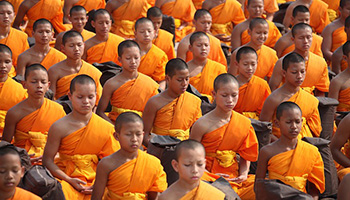
Since the time of Buddha, Vipassana has been, to date, an uninterrupted chain of teachers. Although Indian by descent, the current teacher in this chain, Mr. SNGoenka, was born and raised in Burma (Myanmar). While living there, I was fortunate to learn Vipassana from his teacher Sayagyi U Ba Khin, who at the time was an important member of the government. After receiving training from his teacher for fourteen years, Goenka settled in India and began teaching Vipassana in 1969. Since then he has taught tens of thousands of people of all races and religions in both the East and West . In 1982 he began to appoint assistant teachers to help him meet the growing demand for Vipassana courses.
Courses: techniques taught in ten-day courses in which participants follow a prescribed Code of Discipline, learn the basics of the method and practice sufficiently to experience its beneficial results.
The course requires hard, serious work. There are three steps to the training. The first step is that during the course time to refrain from killing, stealing, sexual activity, speaking falsely, and intoxicants. This simple code of moral conduct serves to calm the mind, which otherwise would be too agitated to perform the task of self-observation. The next step is to develop a certain capacity of the mind by learning to fix your attention on the natural reality of the ever changing and toilets changes when entering and leaving the nostrils. On the fourth day the mind is calmer and more focused, it is more able to practice Vipassana training: observing sensations in the body, understanding their nature and develop equality to learn not to react to them.
All training is actually a mental training. Just as we use physical exercises to improve our attention, Vipassana can be used to develop a healthy mind.
Since it has proven to be really useful, great emphasis is placed on preserving the technique in its original and authentic form. It is not taught commercially, but is offered freely. No person involved in teaching has no material compensation. There is no charge for the courses, not even to cover the cost of food and accommodation. All expenses are covered by donations from people who, having completed a course and experienced the benefits of Vipassana, wish to give others the opportunity to benefit from it too.
The result will, of course, gradually through continuous practice. It is unrealistic to expect all problems to be solved in ten days. Meanwhile, however, the materiality of Vipassana is taught so that it can be applied in everyday life. The more the technique is practiced, the greater the freedom from misery and approaches closer to the ultimate goal of full liberation. Even ten days can provide results which are vivid and obviously beneficial in everyday life.
All sincere people are welcome to join a Vipassana course to see how the technique works and to measure the benefits. All who try it will find Vipassana is an invaluable achieve and share real happiness with others tool.
